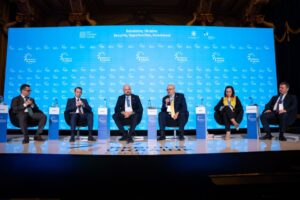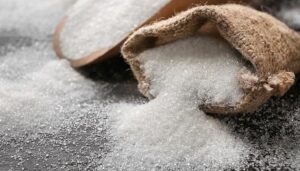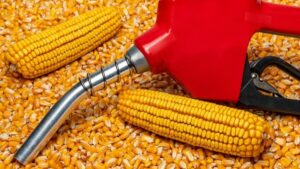
At the Rebuilding Ukraine: Security, Opportunities, Investments forum in Bucharest, during one of the panel discussions, representatives of Romania, the Republic of Moldova, and Ukraine announced their intention to deepen regional cooperation in infrastructure within the “strategic transport triangle” to support Ukraine’s reconstruction and strengthen the region’s resilience.
The panel was moderated by George Scutaru, CEO of the New Strategy Center think tank. Participants included Vladimir Bolea, Deputy Prime Minister and Minister of Infrastructure and Regional Development of the Republic of Moldova; Mihai Iurca, Special Envoy for the Reconstruction of Ukraine and Head of the Office of the Prime Minister of Romania; First Deputy Chair of the Verkhovna Rada Committee on Transport and Infrastructure Yulia Sirko, State Secretary of the Ministry of Infrastructure of Romania Ionel Scrieşteanu, Deputy Minister of Communities, Territories and Infrastructure of Ukraine Serhiy Derkach (via videoconference), and CEO of Leviatan Group Cătălin Podaru.
The discussion focused on the strategic importance of regionalizing infrastructure projects between the three countries and developing logistics corridors that ensure not only economic and demographic mobility, but also military mobility in the context of the ongoing war. The participants emphasized that transport and energy connectivity is seen as a tool for coordinating government policies, as well as a platform for involving the private sector in the reconstruction of Ukraine.
“Logistics is becoming a key element of security and development: from ports and railways to border infrastructure, all of this must function as a single network between Romania, Moldova, and Ukraine,” Skutaru noted during the discussion. He stressed that coordinating investments and projects within the “strategic transport triangle” is a necessary condition for increasing the capacity of corridors used for trade, transit, and military aid.
Representatives of the Ukrainian and Moldovan sides stressed that the reconstruction of Ukraine is impossible without the active participation of private business and the involvement of international companies in joint projects. “Ukraine is open to partnership, and we need both financial resources and technological solutions that can be provided by regional and global partners. Joint infrastructure projects strengthen not only the economy but also the stability of the entire region,” emphasized Deputy Minister Serhiy Derkach.
Following the discussion, participants noted positive dynamics in strengthening connectivity between the three countries, particularly with regard to the modernization of transport corridors, port, and border infrastructure. They concluded that further progress will depend on coordinated government action, effective use of financial instruments, and close cooperation with international partners to enhance the collective resilience and prosperity of the region.
The forum “Rebuilding Ukraine: Security, Opportunities, Investments” is being held on December 11-12 in Bucharest under the auspices of the Romanian Ministry of Foreign Affairs and the Ukrainian Ministry of Foreign Affairs and organized by the New Strategy Center. According to the organizers, more than 30 panel discussions and parallel sessions are planned over two days with the participation of representatives of governments, international organizations, the private sector, financial institutions, and experts from Europe, North America, and Asia. The topics of the panels cover security and defense, infrastructure, financing and investment, green energy, digitalization, human capital, and cross-border cooperation.

Ukrainian sugar in 2025 turned out to be a very bitter topic and a sore point in negotiations on trade in agricultural products with the European Union. The industry’s plans for 2026 are to increase the share of Ukrainian sugar on the European market, said Yana Kavushevska, head of the National Association of Sugar Producers of Ukraine “Ukrtsukor,” Yana Kavushevska at the conference “Agribusiness in Ukraine” in Kyiv on Thursday.
She noted that during the preparation of the updated trade agreement, the Ukrainian side was not prepared to deal with the powerful sugar lobby and its stakeholders in the EU, along with their strong support at the political level.
Another surprise was the European community’s bias against Ukrainian agricultural products. Among the most absurd myths, Kavushevska named the inexhaustible potential of the Ukrainian agricultural sector, the dominance of agricultural oligarchs, etc. Both Ukrainian agricultural associations and government officials had to refute these myths.
“One of the areas of our communication was to explain to Europeans that the Ukrainian sugar industry is a continuation of the European one. We use all the inputs that we purchase in the European Union in our work. (…) For every hectare of sugar beet, we purchase approximately $1,000 worth of goods in the EU. Accordingly, this year we have 200,000 hectares of sugar beet in Ukraine, for which we have purchased $200 million worth of products from the EU,” said the head of Ukrtsukor, adding that such arguments either surprise or are ignored by her European colleagues.
Speaking about the quotas that Ukraine received for sugar supplies to the EU under the updated trade agreement, Kavushevska noted that they had increased fivefold compared to the previous ones.
“Indeed, the results we have achieved with the quota received in the European Union for sugar show a fivefold increase — from 20,000 tons to 100,000 tons. Is this a lot or a little? Probably no one could be satisfied. But I am sure that if there had been no effective agricultural and social communication, this quota could have been smaller,” said the head of Ukrtsukor.
She stressed that the EU likes predictability, balance, and foreseeability. This is how she explained the need for Ukraine to introduce internal licensing for sugar exports to the European Union. In her opinion, this mechanism will allow Ukrainian sugar producers to eventually become not just technical suppliers of products to the EU, but gradually transform into full-fledged members of the European market.
“Yes, it costs producers who want to export additional expenses for obtaining documents, complications, and delays in possible deliveries. But this (internal quotas – IF-U) is what demonstrates to Europeans that we know how to work and regulate the market,” the expert explained.
Kavushevska named another complication of the updated trade agreement for sugar producers as the European Union’s application of the concept of a “critical quota” to Ukrainian sugar. It provides for the importer to deposit financial guarantees into special accounts, which will be returned to them 3-30 days after customs clearance of goods received from Ukraine. According to the expert, this mechanism is one of the ways to prevent the uncontrolled spread of Ukrainian sugar in the EU. At the same time, it is an unpleasant moment for European buyers, who have to freeze their own working capital for a certain period.
Speaking about the sugar producers’ plans for 2026, the head of the association said that the industry will continue to establish contacts with the European sugar industry and hopes that licensing will continue as an export mechanism. In addition, benchmarks will be developed for key production indicators so that the industry can prepare for integration into the European market.
“For Ukrainian sugar producers, the European market is virtually the only option. We cannot compete for Africa because Brazil will always dominate there logistically. Our task is to gain a foothold in Europe, increase Ukraine’s share as much as possible, and eventually ensure the European Union’s self-sufficiency in sugar,” Kavushevska concluded.

Ukraine needs to update its legislation on critical minerals in order to exploit its existing resource potential and strengthen its competitiveness in the global market, participants in a thematic panel at the Ukraine Recovery Forum said. They stressed that without transparent rules of the game, specialized international partnerships, and a stable security environment, the implementation of large projects in the mining sector remains limited.
The panel was moderated by Vitaliy Radchenko, managing partner of CMS Ukraine and head of the energy and climate change practice. The discussion was joined by Volodymyr Tsabal, Secretary of the Verkhovna Rada Committee on Budget, Paul Coyier, Professor at the Institute of World Politics (USA), Ksenia Orynchak, Founder and Executive Director of the National Association of Extractive Industries of Ukraine, and Greg Swenson, Chairman of Republicans Overseas UK.
According to the speakers, Ukraine has significant reserves of critical raw materials, but the existing regulatory framework does not fully meet the requirements of international investors and specialized financial institutions. They emphasized the need for clear procedures for access to deposits, understandable risk-sharing mechanisms, and investment protection guarantees. “If Ukraine wants to occupy a prominent place in global supply chains for critical minerals, it needs modernized rules that are understandable to transnational companies and export credit agencies,” Tsabal said.
Separately, participants drew attention to China’s dominant role in the mineral processing segment, which poses significant risks to Western economies. In this context, the strategic partnership between Ukraine and the US, in their opinion, could become a tool for diversifying supply sources, as well as a channel for attracting capital and technology. “Cooperation with Ukraine makes it possible to reduce dependence on a limited number of suppliers and at the same time support the reconstruction of a country that is on the front line of the conflict,” Swenson emphasized.
At the same time, experts reminded that the implementation of projects in the extractive sector directly depends on the security situation. They noted that some of the territories rich in minerals are currently under Russian occupation, which complicates the planning and launch of new investment initiatives. According to the participants in the discussion, achieving lasting peace and creating a predictable security environment is a necessary condition for transforming Ukraine’s resource potential into real economic results.
The forum “Rebuilding Ukraine: Security, Opportunities, Investments” is being held on December 11-12 in Bucharest under the auspices of the Romanian Ministry of Foreign Affairs and the Ukrainian Ministry of Foreign Affairs and is organized by the New Strategy Center. According to the organizers, more than 30 panel discussions and parallel sessions are planned over two days with the participation of representatives of governments, international organizations, the private sector, financial institutions, and experts from Europe, North America, and Asia. The topics of the panels cover security and defense, infrastructure, financing and investment, green energy, digitalization, human capital, and cross-border cooperation.

In Ukraine, approximately 1 million tons of capacity for processing corn into bioethanol is currently being built within industrial parks, which will require 3 million tons of corn annually to meet their raw material needs, according to Taras Mykolayenko, director of the Ukrainian Association of Bioethanol Producers.
“As soon as there is talk of creating a new industrial park, every second one envisages the production of bioethanol. We have 1 million tons of capacity that is just starting to be laid. If we convert (these figures – IF-U) into corn, we need 3 million tons. So, in an optimistic scenario, at full capacity (of bioethanol plants – IF-U), corn will be processed here,“ he said at the conference ”Agribusiness in Ukraine” in Kyiv on Thursday.
Mykolaienko specified that Europe currently consumes 6 million tons of bioethanol per year, so Ukrainian products could definitely be exported to the European Union. As part of the updated trade agreement, the EU, under the influence of its own producers, planned to set a quota for Ukraine at 100,000 tons, which, as a result of negotiations, the Ukrainian side was able to increase to 125,000 tons. The industry plans to increase it to 300,000 tons by 2026.
At the same time, he recalled that in July 2025, a bill was registered in the Verkhovna Rada, which provides for the introduction of a mandatory addition of more than 7% bioethanol to fuel in Ukraine from July 2026, the share of which should ideally be 10%. A similar requirement will apply to imported goods. Accordingly, bioethanol consumption in the domestic market will increase.
In addition, Mykolaienko said that the industry association will try to protect its own domestic market in 2026.
“We are faced with the fact that, in addition to quotas, there are technical regulations in the European Union. These are real non-trade barriers that work well. (…) If necessary, Europeans have a mechanism to stop exports. We plan to develop the same mechanisms, develop and implement a domestic environmental certification system, and we will also protect the Ukrainian market,” concluded the head of the Ukrainian Association of Bioethanol Producers.

According to Serbian Economist, Krakow, Poland, has been recognized as the cleanest city in the world by Radical Storage, which analyzed more than 70,000 tourist reviews of the 100 largest destinations from Euromonitor International’s Top 100 City Destinations index.
According to the study, 98.5% of reviews mentioning Krakow’s cleanliness were positive. The top five also included Sharjah in the UAE (98% positive reviews), Singapore (97.9%), Warsaw (97.8%), and Doha (97.4%).
The top 20 cleanest cities in the world include Krakow, Sharjah, Singapore, Warsaw, Doha, Riyadh, Prague, Muscat, Dubai, Fukuoka, Abu Dhabi, Zurich, Edinburgh, Los Angeles, Lima, Cancun, Porto, Copenhagen, Taipei, and Valencia, with all of them receiving over 94% positive reviews for cleanliness.
Radical Storage indicates that it selected 100 cities from the Euromonitor Top 100 City Destinations index for analysis and reviewed the 10 most popular attractions in each city. Only English-language Google reviews from October 2024 to November 2025 that contained the words “clean” or “dirty” were taken into account, after which the mentions were classified as positive or negative. A total of 71,692 mentions of ‘clean’ and 10,165 mentions of “dirty” were processed.
According to the company, the authors of the study attribute the high rankings of Krakow and Warsaw to Poland’s investments in waste management systems and the improvement of public spaces, as well as the involvement of residents in city clean-up campaigns.
Serbian cities are not included in the study.
https://t.me/relocationrs/1923